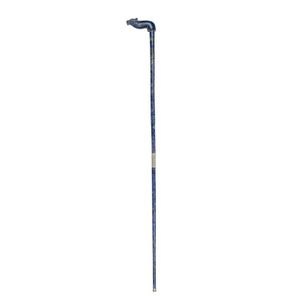Whalebone walking stick with greenstone handle
You must be a subscriber, and be logged in to view price and dealer details.
Subscribe Now to view actual auction price for this item
When you subscribe, you have the option of setting the currency in which to display prices to $Au, $US, $NZ or Stg.
- Incised - A record of a name, date or inscription, or a decoration scratched into a surface, usually of a glass or ceramic item with a blunt instrument to make a coarse indentation. Compare with engraving where the surface is cut with a sharp instrument such as a metal needle or rotating tool to achieve a fine indentation.
- Baleen - Baleen is the filter feeder system in a baleen whale, and these whales have several hundred plates of baleen with a hairy fringe on their upper jaw.
Baleen refers to the solid plate, and it is historically important as it was sought by whalers as a by-product of the whaling industry, who called it whalebone, though it is not made of bone at all, and used it for scrimshaw.
The earliest artefacts were made of baleen produced from Arctic whaling in the 17th century.
In the 19th century baleen was an important raw material, comparable to present-day plastics. Its thermoplastic nature and strength meant it could be used to make a wide variety of functional and decorative objects.
Sailors used baleen to make sewing boxes and other small containers and another common use was brush bristles; it was even used as runners on toboggans.
Baleen basketry was developed into a craft, with examples of simple baskets to complex woven ones, which could take months to complete.
Other shore-based uses included in corsets, buggy whips, umbrella ribs, canes, skirt hoops and especially as a cheaper substitute for ivory in carving. - Wrythen - A spirally twisted ornamentation most commonly found on antique glass, silver, ceramics and furniture.
This item has been included into following indexes:
Visually similar items

Kakauroa - long handled axe early example with early iron trade axe head, shaft carved with figures, koru design with pataki and single and double heihei lines, shaft end carved with traditional taiaha style tongue, rich dark brown patina, length 102.5 cm

Walking stick with bone / marine ivory dog handle, approx 92 cmlong

A fine lapis lazuli walking cane with silver collar, most likely Mogul Indian, 19th century. 77 cm high

A Georgian walking stick, segmented tortoise shell and brass, 88 cm long
